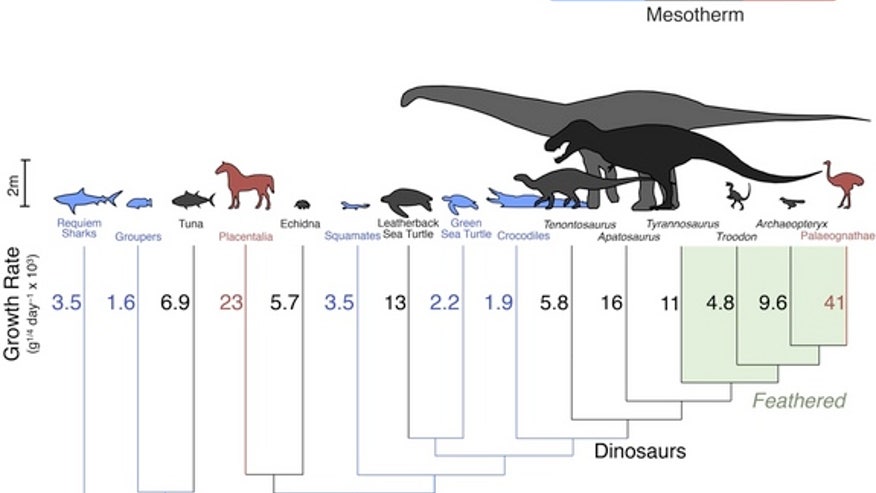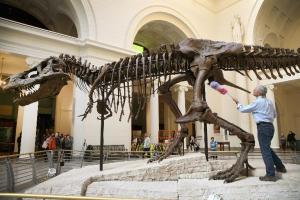Pteranodon (
//; from
Greek πτερόν ("wing") and ἀνόδων ("toothless")) is a
genus of
pterosaurs which included some of the largest known flying
reptiles, with wingspans over 6 metres (20 ft). It existed during the late
Cretaceous geological period of
North America in present day
Kansas,
Alabama,
Nebraska,
Wyoming, and
South Dakota. More
fossil specimens of
Pteranodon
have been found than any other pterosaur, with about 1,200 specimens
known to science, many of them well preserved with nearly complete
skulls and articulated skeletons. It was an important part of the animal
community in the
Western Interior Seaway.
[1]
Pteranodon was not a
dinosaur. By definition, all dinosaurs belong to the groups
Saurischia and
Ornithischia, which exclude pterosaurs. Nevertheless,
Pteranodon is frequently featured in dinosaur books and is strongly associated with dinosaurs by the general public.
[2]
Description
Pteranodon species are extremely well represented in the
fossil record, allowing for detailed descriptions of their anatomy and
analysis of their life history. Over 1,000 specimens have been
identified, though less than half are complete enough to give
researchers good information on the anatomy of the animal. Still, this
is more fossil material than is known for any other pterosaur, and it
includes both male and female specimens of various age groups and,
possibly, species.
[2]
Size

Size of
P. longiceps male (green) and female (orange) compared with a human
Adult
Pteranodon specimens from the two major species can be
divided into two distinct size classes. The smaller class of specimens
have small, rounded head crests and very wide pelvic canals, even wider
than those of the much larger size class. The size of the pelvic canal
probably allowed the laying of eggs, indicating that these smaller
adults are females. The larger size class, representing male
individuals, have narrow hips and very large crests, which were probably
for display.
Adult male
Pteranodon were among the largest pterosaurs, and were the largest flying animals known until the late 20th Century, when the giant
azhdarchid pterosaurs were discovered.
[2] The wingspan of an average adult male
Pteranodon was 5.6 metres (18 ft). Adult females were much smaller, averaging 3.8 metres (12 ft) in wingspan. The largest specimen of
Pteranodon longiceps from the
Niobrara Formation measured 6.25 metres (20.5 ft) from wingtip to wingtip. An even larger specimen is known from the
Pierre Shale Formation, with a wingspan of 7.25 metres (23.8 ft), though this specimen may belong to the distinct genus and species
Geosternbergia maysei.
[2] While most specimens are found crushed, enough fossils exist to put together a detailed description of the animal.
Methods used to estimate the weight of large male
Pteranodon
specimens (those with wingspans of about 7 meters) have been notoriously
unreliable, producing a wide range of estimates from as low as 20
kilograms (44 lb) and as high as 93 kilograms (210 lb). In a review of
pterosaur size estimates published in 2010, researchers Mark Witton and
Mike Habib demonstrated that the latter, largest estimates are almost
certainly incorrect given the total volume of a
Pteranodon body, and could only be correct if the animal "was principally comprised of
aluminium."
[3]
Witton and Habib considered the methods used by researchers who
obtained smaller weight estimates equally flawed. Most have been
produced by scaling modern animals such as bats and birds up to
Pteranodon size, despite the fact that pterosaurs have vastly different body proportions and soft tissue anatomy from any living animal.
[3]
Skull and beak
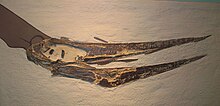
Skull and beak of specimen AMNH 7515
Unlike earlier pterosaurs such as
Rhamphorhynchus and
Pterodactylus,
Pteranodon had toothless
beaks, similar to those of modern
birds.
Pteranodon
beaks were made of solid, bony margins that projected from the base of
the jaws. The beaks were long, slender, and ended in thin, sharp points.
The upper jaw was longer than the lower jaw. The upper jaw was curved
upward; while this normally has been attributed only to the
upward-curving beak, one specimen (UALVP 24238) has a curvature
corresponding with the beak widening towards the tip. While the tip of
the beak is not known in this specimen, the level of curvature suggests
it would have been extremely long. The unique form of the beak in this
specimen lead
Alexander Kellner to assign it to a distinct genus,
Dawndraco, in 2010.
[4]
The most distinctive characteristic of
Pteranodon is its
cranial crest. These crests consisted of skull bones (frontals)
projecting upward and backward from the skull. The size and shape of
these crests varied due to a number of factors, including age, sex, and
species. Male
Pteranodon sternbergi, the older species of the two described to date (and sometimes placed in the distinct genus
Geosternbergia), had a more vertical crest with a broad forward projection, while their descendants,
Pteranodon longiceps, evolved a narrower, more backward-projecting crest.
[1] Females of both species were smaller and bore small, rounded crests.
[5] The crests were probably mainly display structures, though they may have had other functions as well.
[6]
Skeleton
Other distinguishing characteristics that set
Pteranodon apart from other pterosaurs include narrow
neural spines
on the vertebrae, plate-like bony ligaments strengthening the vertebrae
above the hip, and a relatively short tail in which the last few
vertebrae are fused into a long rod.
[7] The entire length of the tail was about 3.5% as long as the wingspan, or up to 25 centimetres (9.8 in) in the largest males.
[7]
Timespan and evolution
Pteranodon fossils are known primarily from the
Niobrara Formation of the central
United States. Broadly defined,
Pteranodon existed for more than four million years, during the late
Coniacian to early
Campanian stages of the
Cretaceous period.
[5] The genus is present in most layers of the Niobrarra Formation except for the upper two; in 2003,
Kenneth Carpenter surveyed the distribution and dating of fossils in this formation, demonstrating that
Pteranodon sternbergi existed there from 88 to 85 million years ago, while
P. longiceps existed between 86 and 84.5 million years ago. A possible third species, which Kellner named
Geosternbergia maysei in 2010, is known from the Sharon Springs member of the
Pierre Shale Formation in Kansas,
Wyoming, and
South Dakota, dating to between 81.5 and 80.5 million years ago.
[8]
In the early 1990s, Bennett noted that the two major
morphs
of pteranodont present in the Niobrara Formation were precisely
separated in time with little, if any, overlap. Due to this, and to
their gross overall similarity, he suggested that they probably
represent
chronospecies within a single evolutionary lineage lasting about 4 million years. In other words, only one species of
Pteranodon would have been present at any one time, and
P. sternbergi (or
Geosternbergia) in all likelihood was the direct ancestor species of
P. longiceps.
[2]
Biology and ecology
Range and environment
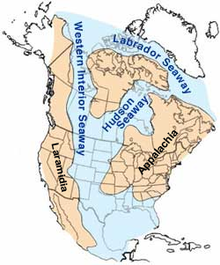
Map of North America during the mid-Cretaceous Period, illustrating the Western Interior Seaway
Specimens assigned to
Pteranodon have been found in both the
Smoky Hill Chalk deposits of the
Niobrara Formation, and the slightly younger Sharon Springs deposits of the
Pierre Shale Formation. When
Pteranodon was alive, this area was covered by a large inland sea, known as the
Western Interior Seaway. Famous for fossils collected since 1870, these formations extend from as far south as
Kansas in the
United States to
Manitoba in
Canada. However,
Pteranodon specimens (or any pterosaur specimens) have only been found in the southern half of the formation, in Kansas,
Wyoming, and
South Dakota.
Despite the fact that numerous fossils have been found in the
contemporary parts of the formation in Canada, no pterosaur specimens
have ever been found there. This strongly suggests that the natural
geographic range of
Pteranodon covered only the southern part of the Niobrara, and that its habitat did not extend farther north than South Dakota.
[5]
Some very fragmentary fossils belonging to pteranodontian pterosaurs, and possibly
Pteranodon itself, have also been found on the
Gulf Coast and
East Coast of the United States. For example, some bone fragments from the
Mooreville Formation of
Alabama and the
Merchantville Formation of
Delaware may have come from
Pteranodon, though they are too incomplete to make a definite identification.
[5] Some remains from Japan have also been tentatively attributed to
Pteranodon, but their distance from its known Western Interior Seaway habitat makes this identification unlikely.
[5]
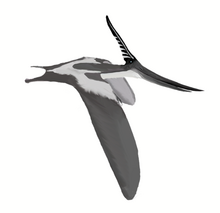
Life restoration of an adult male
P. longiceps in flight
Pteranodon longiceps would have shared the sky with the giant-crested pterosaur
Nyctosaurus. Compared to
P. longiceps, which was a very common species,
Nyctosaurus was rare, making up only 3% of pterosaur fossils from the formation. Also less common was the early toothed
bird,
Ichthyornis.
[8]
It is likely that, as in other polygynous animals (in which males compete for association with harems of females),
Pteranodon lived primarily on offshore rookeries, where they could nest away from land-based predators and feed far from shore; most
Pteranodon fossils are found in locations which at the time, were hundreds of kilometres from the coastline.
[6]
Below the surface, the sea was populated primarily by invertebrates such as
ammonites and
squid. Vertebrate life, apart from basal fish, included
sea turtles such as
Toxochelys, the
plesiosaur Styxosaurus, and the flightless diving bird
Parahesperornis.
Mosasaurs were the most common marine reptiles, with genera including
Clidastes and
Tylosaurus.
[1] At least some of these marine reptiles are known to have fed on
Pteranodon.
Barnum Brown, in 1904, reported plesiosaur stomach contents containing "pterodactyl" bones, most likely from
Pteranodon.
[9]
Fossils from terrestrial
dinosaurs
also have been found in the Niobrara Chalk, suggesting that animals who
died on shore must have been washed out to sea (one specimen of a
hadrosaur appears to have been scavenged by a
shark).
[10]
Flight

Skeletal reconstruction of a quadrupedally launching male
Pteranodon longiceps
The wing shape of
Pteranodon suggests that it would have flown rather like a modern-day
albatross. This is based on the fact that
Pteranodon had a high
aspect ratio (wingspan to
chord length) similar to that of the albatross — 9:1 for
Pteranodon, compared to 8:1 for an albatross. Albatrosses spend long stretches of time at sea fishing, and use a flight pattern called "
dynamic soaring"
which exploits the vertical gradient of wind speed near the ocean
surface to travel long distances without flapping, and without the aid
of
thermals (which do not occur over the open ocean the same way they do over land).
[11] While most of a
Pteranodon
flight would have depended on soaring, like long-winged seabirds, it
probably required an occasional active, rapid burst of flapping, and
studies of
Pteranodon wing loading (the strength of the wings vs.
the weight of the body) indicate that they were capable of substantial
flapping flight, contrary to some earlier suggestions that they were so
big they could only glide.
[3]
Like other pterosaurs,
Pteranodon probably took off from a
standing, quadrupedal position. Using their long forelimbs for leverage,
they would have vaulted themselves into the air in a rapid leap. Almost
all of the energy would have been generated by the forelimbs. The
upstroke of the wings would have occurred when the animal cleared the
ground followed by a rapid down-stroke to generate additional lift and
complete the launch into the air.
[3]
Diet
The diet of
Pteranodon is known to have included
fish; fossilized fish bones have been found in the
stomach area of one
Pteranodon, and a fossilized fish
bolus has been found between the jaws of another
Pteranodon,
specimen AMNH 5098. Numerous other specimens also preserve fragments of
fish scales and vertebrae near the torso, indicating that fish made up a
majority of the diet of
Pteranodon (though they may also have taken invertebrates).
[2]
Traditionally, most researchers have suggested that
Pteranodon
would have taken fish by dipping their beaks into the water while in
low, soaring flight. However, this was probably based on the assumption
that the animals could not take off from the water surface.
[2] It is more likely that
Pteranodon could take off from the water, and would have dipped for fish while swimming rather than while flying. Even a small, female
Pteranodon
could have reached a depth of at least 80 centimetres (31 in) with its
long bill and neck while floating on the surface, and they may have
reached even greater depths by plunge-diving into the water from the air
like some modern long-winged seabirds.
[2] In 1994, Bennett noted that the head, neck, and shoulders of
Pteranodon were as heavily built as diving birds, and suggested that they could dive by folding back their wings like the modern
Gannet.
[2]
Crest function
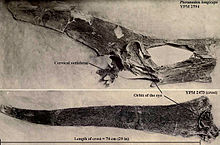
Putative male
Pteranodon longiceps specimens YPM 2594 and 2493
Pteranodon was notable for its skull crest, though the
function of this crest has been a subject of debate. Most explanations
have focused on the blade-like, backward pointed crest of male
P. longiceps,
however, and ignored the wide range of variation across age and sex.
The fact that the crests vary so much rules out most practical functions
other than for use in mating displays.
[12] Therefore, display was probably the main function of the crest, and any other functions were secondary.
[6]
Scientific interpretations of the crest's function began in 1910, when
George Francis Eaton
proposed two possibilities: an aerodynamic counterbalance and a muscle
attachment point. He suggested that the crest might have anchored large,
long jaw muscles, but admitted that this function alone could not
explain the large size of some crests.
[13]
Bennett (1992) agreed with Eaton's own assessment that the crest was
too large and variable to have been a muscle attachment site.
[6]
Eaton had suggested that a secondary function of the crest might have
been as a counterbalance against the long beak, reducing the need for
heavy neck muscles to control the orientation of the head.
[13]
Wind tunnel tests showed that the crest did function as an effective
counterbalance to a degree, but Bennett noted that again, the hypothesis
focuses only on the long crests of male
P. longiceps, not on the larger crests of
P. sternbergi
and very small crests that existed among the females. Bennett found
that the crests of females had no counterbalancing effect, and that the
crests of male
P. sternbergi would, by themselves, have a
negative effect on the balance of the head. In fact, side to side
movement of the crests would have required more, not less, neck
musculature to control balance.
[6]

Short crested
P. longiceps holotype specimen YPM1177, now interpreted as a female individual
In 1943,
Dominik von Kripp suggested that the crest may have served as a
rudder, an idea embraced by several later researchers.
[6][14]
One researcher, Ross S. Stein, even suggested that the crest may have
supported a membrane of skin connecting the backward-pointing crest to
the neck and back, increasing its surface area and effectiveness as a
rudder.
[15] The rudder hypothesis again, does not take into account females nor
P. sternbergi,
which had an upward-pointing, not backward-pointing crest. Bennett also
found that even in its capacity as a rudder, the crest would not
provide nearly so much directional force as simply maneuvering the
wings. The suggestion that the crest was an air brake, and that the
animals would turn their heads to the side in order to slow down,
suffers from a similar problem.
[16]
Additionally, the rudder and air brake hypotheses do not explain why
such large variation exists in crest size even among adults.
[6]
Alexander Kellner suggested that the large crests of the pterosaur
Tapejara,
as well as other species, might be used for heat exchange, allowing
these pterosaurs to absorb or shed heat and regulate body temperature,
which also would account for the correlation between crest size and body
size. There is no evidence of extra blood vessels in the crest for this
purpose, however, and the large, membranous wings filled with blood
vessels would have served that purpose much more effectively.
[6]
With these hypotheses ruled out, the best-supported hypothesis for
crest function seems to be as a sexual display. This is consistent with
the size variation seen in fossil specimens, where females and juveniles
have small crests and males large, elaborate, variable crests.
[6]
Sexual variation

Skeletal reconstruction of a female
P. longiceps
Adult
Pteranodon specimens may be divided into two distinct
size classes, small and large, with the large size class being about one
and a half times larger than the small class, and the small class being
twice as common as the large class. Both size classes lived along side
each other, and while researchers had previously suggested that they
represent different species, Christopher Bennett showed that the
differences between them are consistent with the concept that they
represent females and males, and that
Pteranodon species were
sexually dimorphic.
Skulls from the larger size class preserve large, upward and backward
pointing crests, while the crests of the smaller size class are small
and triangular. Some larger skulls also show evidence of a second crest
that extended long and low, toward the tip of the beak, which is not
seen in smaller specimens.
[6]
The sex of the different size classes was determined, not from the
skulls, but from the pelvic bones. Contrary to what may be expected, the
smaller size class had disproportionately large and wide-set pelvic
bones. Bennett interpreted this as indicating a more spacious birth
canal, through which eggs would pass. He concluded that the small size
class with small, triangular crests represent females, and the larger,
large-crested specimens represent males.
[6]
Note that the overall size and crest size also corresponds to age.
Immature specimens are known from both females and males, and immature
males often have small crests similar to adult females. Therefore, it
seems that the large crests only developed in males when they reached
their large, adult size, making the sex of immature specimens difficult
to establish from partial remains.
[17]
The fact that females appear to have outnumbered males two to one
suggests that, as with modern animals with size-related sexual
dimorphism, such as
sea lions and other
pinnipeds,
Pteranodon might have been
polygynous, with a few males competing for association with groups consisting of large numbers of females. Similar to modern pinnipeds,
Pteranodon
may have competed to establish territory on rocky, offshore rookeries,
with the largest, and largest-crested, males gaining the most territory
and having more success mating with females. The crests of male
Pteranodon
would not have been used in competition, but rather as "visual
dominance-rank symbols", with display rituals taking the place of
physical competition with other males. If this
hypothesis is correct, it also is likely that male
Pteranodon
played little to no part in rearing the young; such a behavior is not
found in the males of modern polygynous animals who father many
offspring at the same time.
[6]
Terrestrial locomotion

Replica
P. longiceps skeleton mounted in a quadrupedal posture
-
- Main article: Pterosaur: Ground movement
Historically, the terrestrial locomotion of
Pteranodon, especially whether it was
bipedal or
quadrupedal,
has been the subject of debate. Today, most pterosaur researchers agree
that pterosaurs were quadrupedal, thanks largely to the discovery of
pterosaur
trackways.
[18]
The possibility of aquatic locomotion via swimming has been discussed
briefly in several papers (Bennett 2001, 1994, and Bramwell &
Whitfield 1974), and has been studied in detail at
Michigan State University through the use of
morphometrics and an
extant phylogenetic bracket (a morphologically comparative technique invented by
Larry Witmer).
[16][19]
Discovery and history
Pteranodon was the first pterosaur found outside of
Europe. Its fossils first were found by
Othniel Charles Marsh in 1870, in the Late Cretaceous
Smoky Hill Chalk deposits of western Kansas. These
chalk beds were deposited at the bottom of what was once the
Western Interior Seaway,
a large shallow sea over what now is the midsection of the North
American continent. These first specimens, YPM 1160 and YPM 1161,
consisted of partial wing bones, as well as a tooth from the prehistoric
fish
Xiphactinus,
which Marsh mistakenly believed to belong to this new pterosaur (all
known pterosaurs up to that point had teeth). In 1871, Marsh named the
find
Pterodactlyus Oweni, assigning it to the well-known (but much smaller) European
genus Pterodactylus. Marsh also collected more wing bones of the large pterosaur in 1871. Realizing that the name
Pterodactylus oweni already had been used in 1864 for a specimen of the European
Pterodactylus, Marsh re-named his North American pterosaur
Pterodactylus occidentalis,
meaning "Western wing finger," in his 1872 description of the new
specimen. He also named two additional species, based on size
differences:
Pterodactylus ingens (the largest specimen so far), and
Pterodactlyus velox (the smallest).
[5]

Early illustration of
Ornithochirus umbrosus (now
Pteranodon), when teeth erroneously were attributed to the species and the crest was unknown, 1872
Meanwhile, Marsh's rival
Edward Drinker Cope
also had unearthed several specimens of the large North American
pterosaur. Based on these specimens, Cope named two new species,
Ornithochirus umbrosus and
Ornithochirus harpyia, in an attempt to assign them to the large European genus
Ornithocheirus. As he misspelled the name (forgetting the 'e'), however, he accidentally created an entirely new genus.
[5] Cope's paper naming his ''
Ornithochirus
species was published in 1872, just five days after Marsh's paper. This
resulted in a dispute, fought in the published literature, over whose
names had priority in what obviously were the same species.
[5] Cope conceded in 1875 that Marsh's names did have priority over his, but maintained that
Pterodactylus umbrosus was a distinct species (but not genus) from any that Marsh had named previously.
[20] Re-evaluation by later scientists has supported Marsh's case, and found that Cope's assertion that
P. umbrosus was a larger, distinct species were incorrect.
[5]
While the first
Pteranodon wing bones were collected by Marsh and Cope in the early 1870s, the first
Pteranodon skull was found on May 2, 1876, along the
Smoky Hill River in
Wallace County (now Logan County), Kansas, USA, by
Samuel Wendell Williston, a fossil collector working for Marsh.
[1]
A second, smaller skull soon was discovered as well. These skulls
showed that the North American pterosaurs were different from any
European species, in that they lacked teeth. Marsh recognized that this
major difference, describing the specimens as "distinguished from all
previously known genera of the order Pterosauria by the entire absence
of teeth." Marsh recognized that this characteristic warranted a new
genus, and he coined the name
Pteranodon ("wing without tooth") in 1876. Marsh also reclassified all the previously named North American species from
Pterodactylus to
Pteranodon, with the larger skull, YPM 1117, referred to the new species
Pteranodon longiceps.
[21] He also named an additional species,
Pteranodon gracilis,
based on a wing bone that he mistook for a pelvic bone. He soon
realized his mistake, and re-classified that specimen into a separate
genus, which he named
Nyctosaurus.
[22]
Some of the most influential studies of
Pteranodon during the 20th Century were published by
George Francis Eaton,
who conducted thorough re-analysis of the known specimens and published
some of the first good photographs and illustrations of the best
specimens.
[2]
During the early 1990s, S. Christopher Bennett also published several
major papers reviewing the anatomy, taxonomy and life history of
Pteranodon.
[4]
Fragmentary fossils assigned to
Pteranodon have also been discovered in
Skåne,
Sweden.
[23]
Classification
Valid species

Variation in cranial anatomy and classification of specimens assigned to
Pteranodon (drawn to scale, unpreserved portions shown in gray)
Many researchers consider there to be at least two species of
Pteranodon. However, aside from the differences between males and females described above, the post-cranial skeletons of
Pteranodon
show little to no variation between species or specimens, and the
bodies and wings of all pteranodonts were essentially identical.
[5]
Two species of
Pteranodon are traditionally recognized as valid:
Pteranodon longiceps, the
type species, and
Pteranodon sternbergi.
The species differ only in the shape of the crest in adult males
(described above), and possibly in the angle of certain skull bones.
[5] Because well-preserved
Pteranodon
skull fossils are extremely rare, researchers use stratigraphy (i.e.
which rock layer of the geologic formation a fossil is found in) to
determine species identity in most cases.
Pteranodon sternbergi is the only known species of
Pteranodon with an upright-crest. The lower jaw of
P. sternbergi was 1.25 meters (4 ft) long.
[24] It was collected by
George F. Sternberg in 1952 and described by
John Christian Harksen in 1966, from the lower portion of the Niobrara Formation. It was older than
P. longiceps and is considered by Bennett to be the direct ancestor of the later species.
[5]
Because fossils identifiable as
P. sternbergi are found exclusively in the lower layers of the Niobrara Formation, and
P. longiceps
fossils exclusively in the upper layers, a fossil lacking the skull can
be identified based on its position in the geologic column (though for
many early fossil finds, precise data about its location was not
recorded, rendering many fossils unidentifiable).
[4]
Alternate classifications
Due to the subtle variations between specimens of pteranodontid from
the Niobrara Formation, most researchers have assigned all of them to
the single genus
Pteranodon, in at least two species (
P. longiceps and
P. sternbergi)
distinguished mainly by the shape of the crest. However, the
classification of these two forms has varied from researcher to
researcher. In 1972,
Halsey Wilkinson Miller published a paper arguing that the various forms forms of
Pteranodon were different enough to be placed in distinct sub-genera. He named these
Pteranodon (Occidentalia) occidentalis (for the now-disused species
P. occidentalis) and
Pteranodon (Sternbergia) sternbergi. However, the name
Sternbergia was preoccupied, and in 1978 Miller re-named the species
Pteranodon (Geosternbergia) sternbergi, and named a third subgenus/species combination for
P. longiceps, as
Pteranodon (Longicepia) longiceps. Most prominent pterosaur researchers of the late 20th Century however, including
S. Christopher Bennett and
Peter Wellnhofer, did not adopt these subgeneric names, and continued to place all pteranodont species into the single genus
Pteranodon.
In 2010, pterosaur researcher
Alexander Kellner revisited H.W. Miller's classification. Kellner followed Miller's opinion that the differences between the
Pteranodon species were great enough to place them into different genera. He placed
P. sternbergi into the genus named by Miller,
Geosternbergia, along with the Pierre Shale skull specimen which Bennett had previously considered to be a large male
P. longiceps. Kellner argued that this specimen's crest, though incompletely preserved, was most similar to
Geosternbergia. Because the specimen was millions of years younger than any known
Geosternbergia, he assigned it to the new species
Geosternbergia maysei.
Numerous other pteranodont specimens are known from the same formation
and time period, and Kellner suggested they may belong to the same
species as
G. maysei, but because they lack skulls, he could not confidently identify them.
[4]
Disused species

S.W. Williston's reconstruction of
Ornithostoma ingens, a synonym of
P. longiceps
A number of additional species of
Pteranodon have been named
since the 1870s, although most now are considered to be junior synonyms
of two or three valid species. The best-supported is the
type species,
P. longiceps,
based on the well-preserved specimen including the first-known skull
found by S. W. Williston. This individual had a wingspan of
7 m (23 ft).
[25] Other valid species include the possibly larger,
P. sternbergi, with a wingspan originally estimated at
9 m (30 ft).
[25] P. occidentalis,
P. velox,
P. umbrosus,
P. harpyia, and
P. comptus
are considered to be nomina dubia by Bennett (1994) and others who
question their validity. All probably are synonymous with the more
well-known species.

P. occidentalis mount wherein arms, shoulder girdle, and fingers are actual bones, and the rest has been drawn from other specimens.
Because the key distinguishing characteristic Marsh noted for
Pteranodon was its lack of teeth, any toothless pterosaur jaw fragment, wherever it was found in the world, tended to be attributed to
Pteranodon
during the late nineteenth and early twentieth centuries. This resulted
in a plethora of species and a great deal of confusion. The name became
a
wastebasket taxon, rather like the dinosaur
Megalosaurus,
to label any pterosaur remains that could not be distinguished other
than by the absence of teeth. Species (often dubious ones now known to
be based on sexual variation or juvenile characters) have been
reclassified a number of times, and several
sub-genera have in the 1970s been erected by
Halsey Wilkinson Miller to hold them in various combinations, further confusing the taxonomy (subgenera include
Longicepia,
Occidentalia, and
Geosternbergia). Notable authors who have discussed the various aspects of
Pteranodon include Bennett, Padian, Unwin, Kellner, and Wellnhofer. Two species,
P. orogensis and
P. orientalis, are not pteranodontids and have been renamed
Bennettazhia oregonensis and
Bogolubovia orientalis respectively.
External links
